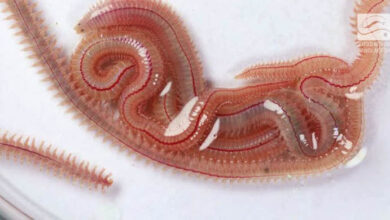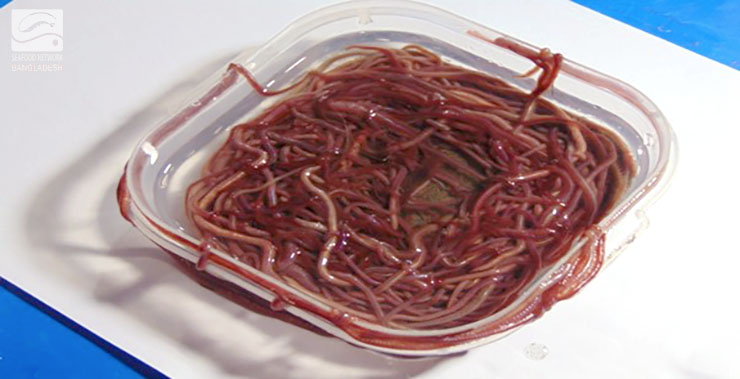
The use of live polychaete helps to reduce shrimp fry mortality and increase shrimp egg production as well. Therefore, the commercial cultivation of polychaete may mark a new era in shrimp and crab farming in Bangladesh, says Professor Jahangir Sarkar from the dept. of Fisheries and Marine Science Department at Noakhali University of Science and Technology . Recent research conducted by his team supports the claim on polychaetes.
According to Jahangir Sarkar, polychaetes usually live one foot deep in the salty clay in the coastal mangrove areas of Bangladesh. They closely resemble earthworms. Inspired by the usage of polychaetes as shrimp feed in England and China hatcheries, he started to investigate it. He then began his research using a grant from the World Bank and the Bangladesh Agricultural Research Council.
How did it Begin?
Professor Jahangir Sarkar said that he became inspired by the use of polychaetes in England and China and then he came up with the concept of commercial farming. Therefore, in 2018, he started research by renting an office in Satkhira and Cox’s Bazar. As part of this, eight species of polychaetes were collected from Satkhira. But there was no way of scientific and accurate identification of polychaetes in this country. So collected samples were identified in a laboratory in Brazil in a collaborative study by Prof. Joanna.
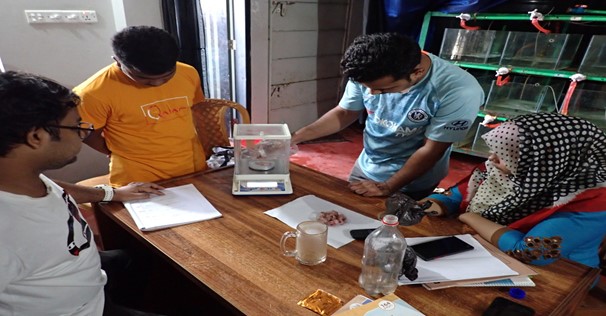
The research indicates that of the eight polychaete species obtained, Namalycastis sp, species is the most effective. This polychaetes species is plentiful year-round and a significant source of omega-3 fatty acids. Aside from this, among the naturally occurring polychaetes, this species is the largest compared to others.
In the laboratory, he actually determined which of the eight collected species contained the most omega-3 fatty acids. Compared to the same species in other countries, this Namalycastis sp, species in Bangladesh, contains more than twice as much omega-3 fatty acids.
Research Results
According to Jahangir Sarkar’s research, the highest-grade feed used in shrimp, crab and fish aquaculture must contain omega-3 fatty acids. This feed is crucial for the shrimp fry, mature shrimp, and crab industries too. Mr. Sarkar said, in the research, he observed that feeding the crabs (Scyla olivaceae) with snail flesh, various formulated feed, and polychaetes feed comprising Namalycastis species boosted their survival rate, body growth and ovary weight.
In addition, after feeding on polychaetes, crabs and their eggs are extremely fatty and bright orange in hue. The demand and popularity of this crab would increase significantly in the global market. Moreover, polychaetes have significant value as feed for shrimp farming and marine ornamental fish, particularly due to their capacity to stimulate up to 70% of the development of shrimp gamete cells.
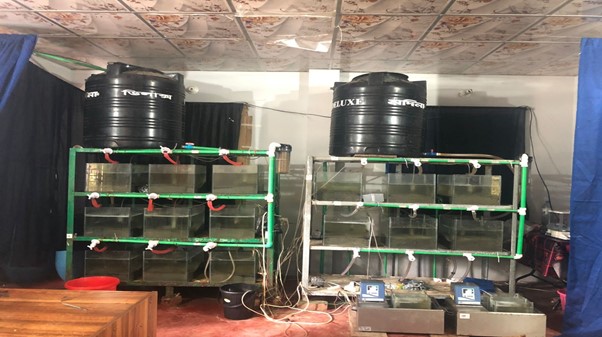
“Supplemental feed made from omega-3-containing polychaetes will play an important role in crab fertility and crab growth when used as crab feed. Apart from this, using polyketides as feed in hatcheries will open new horizons of shrimp farming, which can be an important tool for earning foreign exchange in Bangladesh,” he said.
Polychaete Prospects in Bangladesh
A large number of crab and shrimp are cultivated in Satkhira, Khulna, Cox’s Bazar, and Bagerhat areas of Bangladesh. In 2019-20, the total production of shrimp in the country was about 2.7 million metric tons. Apart from this, in 2019-20 there were about 43 Bagda Hatcheries and 33 Galda Hatcheries in the country. About 792,000 king prawn fry and about 236,000 crab fry have been produced in these hatcheries.
Jahangir Sarkar said that in the shrimp hatcheries in the southwestern part of Bangladesh, a large number of shrimps get sick and even die. The farmers have to count the losses. All in all, the country’s foreign exchange is decreasing in the case of shrimp export. Besides, the country’s standard feed and shrimp quality cannot be maintained.
However, shrimp hatcheries in northern England and China are having great success using polychaetes. They use polychaete as feed for juvenile and adult shrimp. This provides numerous benefits. First, the application of polychaete reduces the mortality of shrimp fry in the hatchery. Second, the egg production rate of shrimp increases by two and a half to three times. About 270 metric tons of polychaetes are produced annually in those two countries
“so, the use of polychaetes to generate formulated feeds will reduce shrimp mortality and greatly enhance output,” he added.
Feed comprises 40–60% of the operational cost of a farm. The reduction of feed prices and the production of high-quality feed is one of the most critical concerns in aquaculture. Fish meal production is restricted by its high price, and fish feed manufacturers are compelled to adopt alternate ingredients. In this case, polychaete might be an important raw material for the production of fish food.
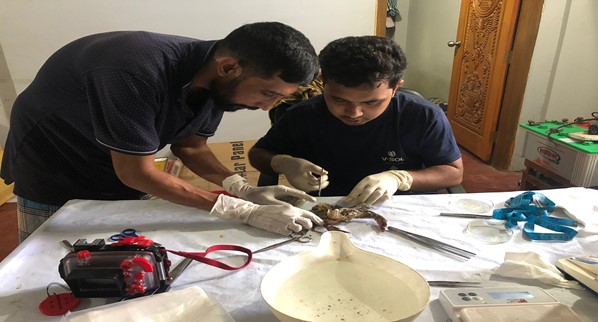
Scenario Around the Globe
Currently, polychaetes are cultivated for shrimp production in several countries. 12 of the 81 families of polychaetes are cultivated globally. According to the FAO fisheries and aquaculture database, 314 tons of Polychaeta were caught in 2016. The global yearly harvest of polychaetes for bait is estimated to be 121,000 metric tons per year.
Polychaetes are among the costliest marine species marketed worldwide (retail price per kilogram), with a price tag of $200 USD kg. About 22 species of polychaetes are harvested in Asia and considered as the region with the largest polychaetes variety. In Africa, seven polychaete species are recorded. Europe has been documented as harvesting twenty polychaete species from the families Arenicolidae, Eunicidae, Lumbrineridae, Nephtyidae, Nereididae, Onuphidae, Sabellidae, Serpulidae, and Spionidae.
Moreover, shrimp hatcheries in northern England and China are having great success using polychaete as feed for juvenile and adult shrimp. The application of it reduces the mortality of shrimp fry in the hatchery. In addition, the egg production rate of shrimp also increases by two and a half to three times. About 270 metric tons of polychaete are produced annually in those two countries.
Future Plans with Polychaete
Mr. Jakir, one of the research assistants from the team said that “polychaete are rich in omega-3 fatty acids, which is vital for the aquaculture industry. Additionally, this is fantastic news for the crab farmers in our country. In Bangladesh, polychaete research is not yet well-known. In our investigation, we discovered the significance of polychaetes, which will considerably benefit our fishing industry. Therefore, if the government and various firms take polychaete farming into consideration, we hope that Bangladesh will take a step forward in fisheries.”
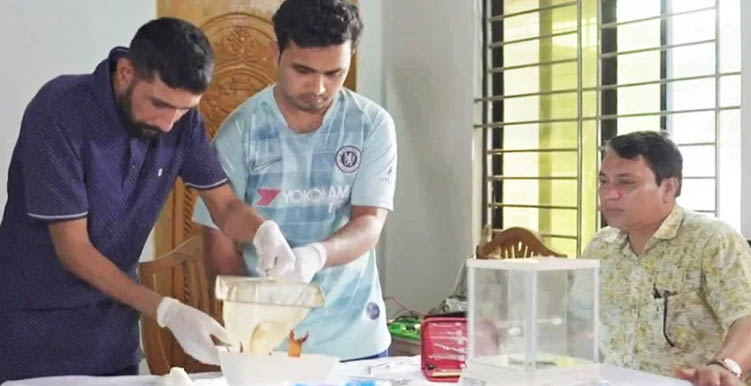
“The head of our team, Professor Dr. Jahangir Sarkar will continue his research on it. He is very optimistic about polychaetes. We have also found benefits in using live polychaetes (Nemalikastis species) in crab farming in another study of ours. Therefore, we will continue our research to bring out more prospects of this valuable organism,” he added.
Now, we can be optimistic too that Polychaete can play an aiding role to the fisheries industry in the country. Now, what it takes is to let industry people know about it and let commercial standard polychaete farms be developed in Bangladesh. Furthermore, commercial cultivation of polychaete may bring foreign exchange once the local demands are fulfilled.
Jaber Bin Abdul Bari
Dept. of Fisheries and Marine Science, NSTU

